
I’m a sim racer with a passion for Motorsport, good racecraft and the tech side of sim racing. I made SIMRACINGCOCKPIT.GG as a place to share my experiences. I hold an International Class C race licence and write for sim racing store G-Performance and Motorsport resource Driver61.com
Featured image: (my) Pimax Crystal VR Headset
I’ve been racing with VR since I bought my first headset: the Valve Index. VR is an entirely different experience from racing with triple monitors. For me, I’m drawn to VR when I feel like a break from monitors. Perhaps most importantly, I tend to switch to VR when I have a Motorsport race coming up.
VR is so much more immersive than monitors. In a race, you look left and there’s a competitor car alongside you. You can fully focus on the track ahead. The experience is like you’re actually sitting in the cockpit of your car. You’re fully immersed in the sim racing environment – it’s the most realistic way to go sim racing. VR can be amazing in the sim.
In my article, I’m going to take a look at device compatibility, display quality (resolution, refresh), FOV (the width of the available display measured in degrees), tracking technology and “softer” variables such as comfort, weight, ease of setup and so on.
There are lots of different headset options to choose from, at varying budget levels. In today’s article I’ve compiled a list of headsets I’ve used, recommend and rate as a great choice at varying budget levels:
What are the Best VR Headsets for Sim Racing?
Currently, we are spoilt for choice when it comes to headsets, but some are far better than others, especially concerning how they handle racing games and how they’re powered.
Each VR headset comes with its advantages and disadvantages, so I’ve gone into some depth below on the features and functions you should pay special attention to when browsing for a new one.
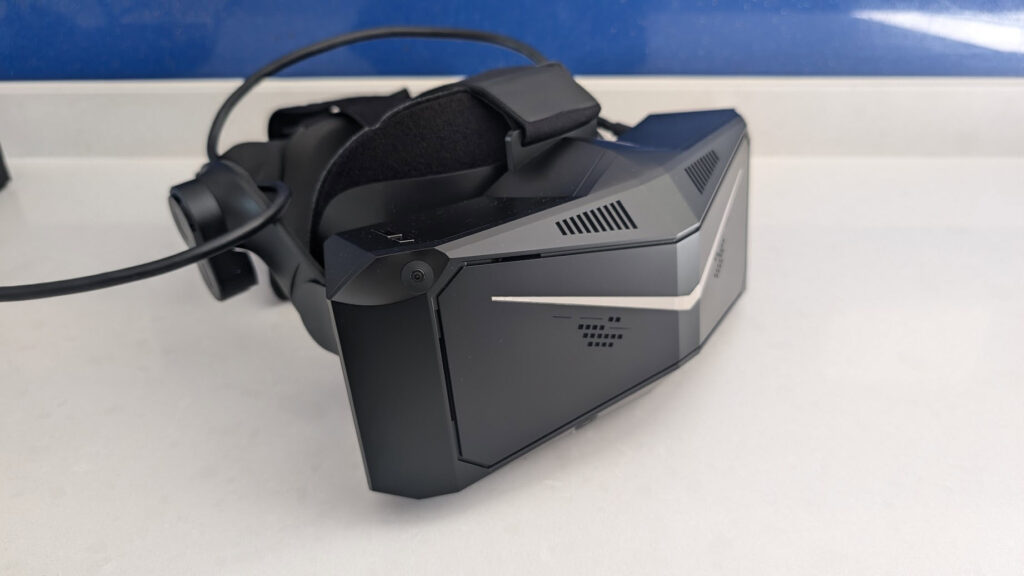
When you’re considering a VR headset for your simulator
There are a lot of things to consider before you buy.
Every VR headset comes with its pros and cons. Don’t fall for the old “which is better” trick when it comes to resolution and maximum refresh rate as there are many more things to take into account before you buy.
Things that can start to become a problem after the novelty of a new VR headset wears off include:
- Constantly having to reset tracking or recentre the HMD
- The Headset loses charge (Pimax Crystal has an onboard battery) and requires a lengthy recharge
- Discomfort
- Too much weight
- Poor ventilation
- Needing to take the headset off constantly when you’re playing with the settings
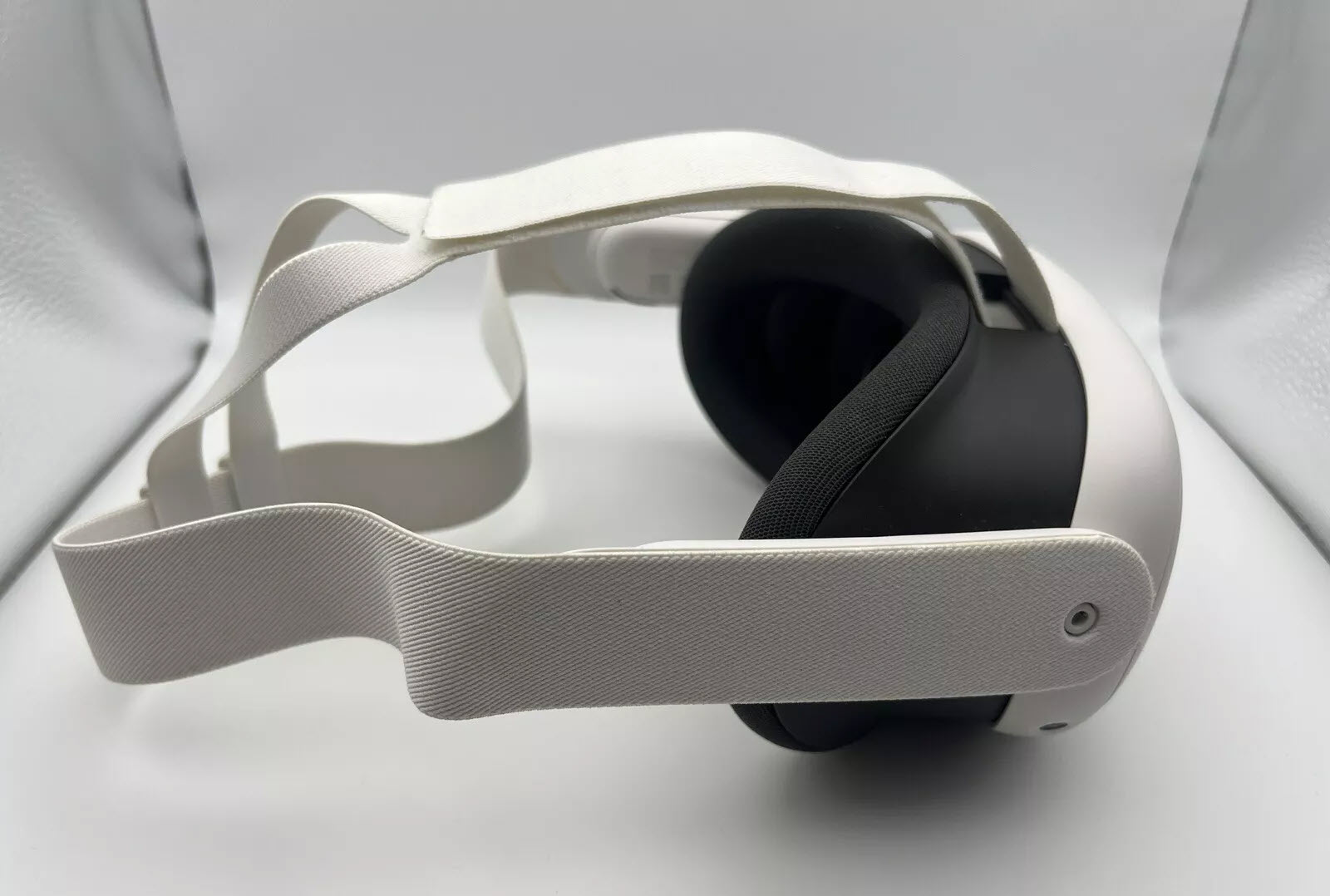

Clearly, VR has advantages, but as my list shows above, there’s always a small cost with modern headsets. If you’re new to sim racing and you’re not sure if VR is right for you, read this article comparing triple monitors vs VR headsets.
In the early days, the Valve Index was, in my opinion among the easiest to set up (check out our graphics settings here) and among the best-performing headsets to use. It would lose tracking from time to time and worse, it could crash my PC before a race! This largely resolved itself with software and firmware updates, and when it worked (99% of the time), it was awesome.
How Do VR Headsets Actually Work?
I’m going to take a look at the main features and components that do all the “heavy lifting” on a VR headset, using my Pimax Crystal as an example.
Display: In the Pimax Crystal, a combination of Mini-LED and QLED panels run at 2880×2880 pixels per eye. This is considered a very high resolution for a gaming VR headset – the Crystal operating at full refresh at this resolution, will stretch the limits of most home gaming PCs. The newer Crystal Light offers QLED technology at the same resolution of 2880 x 2880 per eye.
Lenses: VR headsets use specially designed lenses to focus and magnify the display for each eye. The Pimax Crystal features aspheric glass lenses, which provide a wide maximum field of view (FOV) of up to 125°. Some VR headsets support prescription lenses meaning you don’t have to worry about issues with short or long-sightedness.
Tracking: To communicate the change in perspective as you look around the VR environment, VR headsets must track your head movement. The Pimax Crystal features 4 degrees of freedom (DoF) inside-out tracking, which means it uses built-in sensors to monitor the user’s position and orientation without the need for external base stations. This is really nice – not having to set up external tracking hardware is a real bonus. Older headsets used tracking towers (like the Valve Index). The Varjo Aero remains compatible with the tracking towers making the Aero a sensible upgrade for Valve Index owners.
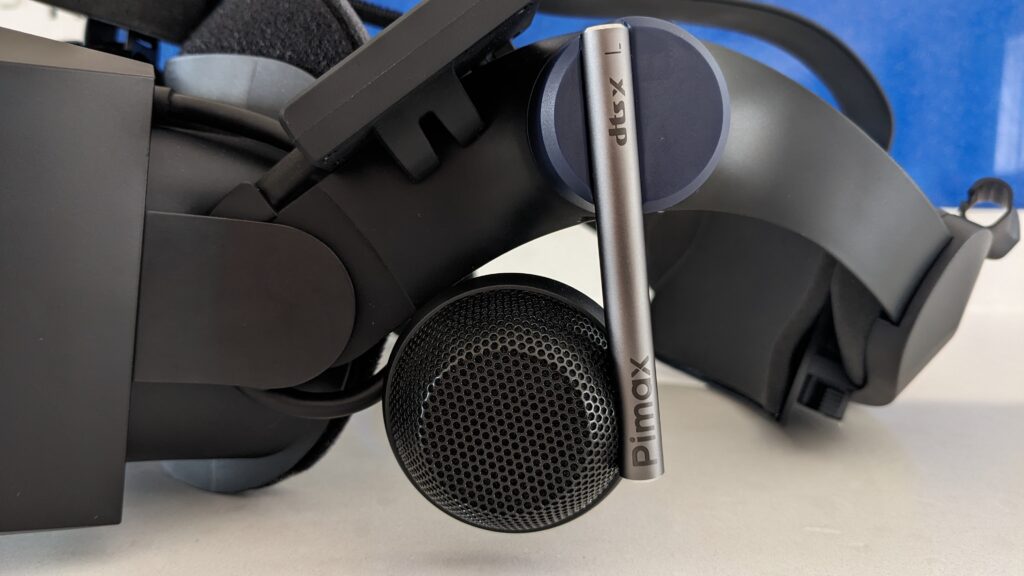

Audio: Good audio helps produce a convincing, deep VR experience. The Pimax Crystal has triple microphones and off-ear speakers (pictured). You can talk with other drivers (via Discord) while in VR, or just be highly aware of the car’s performance (tyre slip, track noises – it’s all extremely important information for sim racing) – this is a game-changer for endurance racing and special events.
Processing: Powerful processing is essential for rendering complex VR environments. The Pimax Crystal is powered by a Qualcomm Snapdragon XR chip and Pimax’s customized PC VR engine (see Pimax Play), ensuring smooth performance and compatibility with a wide range of VR gaming content.
The Crystal and Varjo Aero also feature “auto IPD” (Interpupillary distance) adjustment. Put simply, the headset’s lenses automatically align with your pupils. This improves the clarity of the image and helps with minimising eye strain. As a feature, the automated nature of IPD adjustment is quite new. I had to manually adjust IPD with my Valve Index, just a few years ago. The Crystal Light does not feature auto IPD.
The Crystal will project a screen with crossed, green bars. It instructs you to focus on them as it adjusts the IPD. You can hear the little servo motors moving the lenses, as the image goes in and out of focus. The end result is quite a time saver, as it’s a non-intuitive procedure to do this manually, especially as a new VR user.
So, why should you add VR to your sim racing setup?
Realism
Firstly, and probably most obviously, racing in VR feels real. The accidents, especially!
In iRacing when you leave the pits you often drive straight through another pitted car before you exit. Not a big deal, as it’s not an incident until you’re on the track. But with a VR headset on, the first time you drive through another car, you’ll jump out of your skin.
When you’re gridding up for a race start and look around you by turning your head, your competitors are all there, you’re surrounded. The immersion level is off the scale, especially when the headset has built-in speakers.
Vision
The discipline of using vision to find the best racing line through a corner is the same as driving a track car. As you approach the corner you’re setting a braking point in your peripheral vision because you’re focused on the apex. As you brake, all of your visual focus should be on the exit.
In real racing, you’ll move your head which makes you physically align yourself with the corner’s apex to the exit line.
Scott explains vision so much better than I do, suffice it to say, it’s exactly the same approach in VR. You are then, practising the habits you need to drive on a real track successfully.
Your sensitivity to track detail
VR enables you to “see” details in the circuit you might have missed on monitors. I realized this at Lime Rock Park in the Global Mazda Cup. In VR you can see the camber on the inside of this corner very clearly:
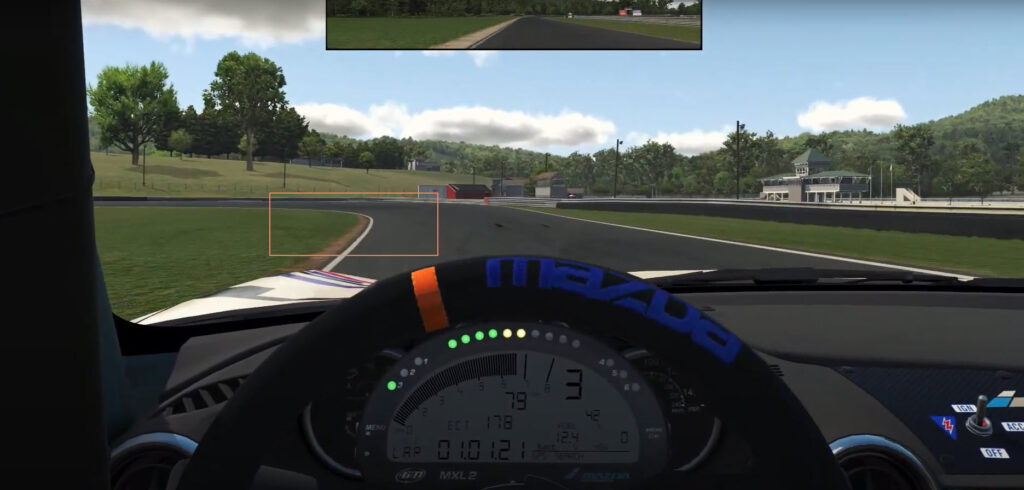

And of course, once you’re visually aware of a track detail, it’s probable that you can feel that detail, too. This brings me to the next benefit of VR.
Early warnings via extra sensory input
It’s easier to drive well with a VR headset because you get an earlier warning of what the car’s doing.
In sim racing, you rely on your ears to sense tyre slip and your eyes to sense rotation in the car. This is a little different to real-life motorsport, in circuit racing on a real track, you’ll sense rotation through your body.
There’s a delay in getting messages like this if you’re looking at monitors which makes catching an accident much more difficult. You start to learn to drive the car from memory, not from feel. This isn’t the case with VR – it seems I’m much more sensitive to smaller movements in the car at corner entry, so I’m already able to predict what the car is going to do.
It’s not magic, you’re just getting the information earlier as your eyes sense your entire environment rotating.
You also get a feel for undulations in the circuit. Using the camber example at Lime Rock Park above, in VR you’re just more aware that the car has climbed over a small hump. It’s a useful sensation once you become aware of it.
That early warning system makes the car easier to control, so you’re driving more consistently.
You drive more accurately
You are fully immersed in an environment and your eyes can feed your brain much more precise data about the way the car is moving.
I think that the way you translate this back into driving inputs is critical. If you know your line and the information you received is accurate, then your steering inputs will be correct. Have you ever approached a corner only to find you’re making last-second adjustments to the line you’re taking? Monitors, especially triple setups are a nightmare for this.
Driving with a monitor is not immersive, so you’re adjusting to a way of seeing things that don’t happen on the track, especially as your line of sight switches from your outside monitor to the one in front of you. Bezel correction is a little annoyance that VR doesn’t suffer from.
But are there any cons to VR Headset use?
Screen door and clarity can be an issue. “Screen door” is a problem solved in the newer headsets, where the fine lines separating pixels (or subpixels) become visible in the displayed image. Clarity remains an issue – where everything can sometimes feel a little bit out of focus. The Valve Index, as good as it was, came from a generation of headsets where the resolution wasn’t quite high enough.
Display quality is mostly determined by the PPD number (Pixels Per Degree) – you can see the difference between the PPD values of different headsets below:
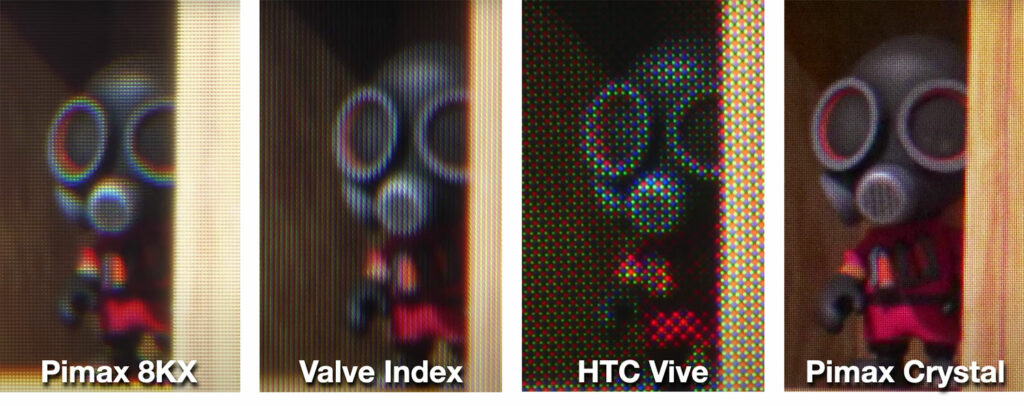

You can go a long way to improving the clarity of the image in your headset by making sure it’s adjusted properly for your face and, of course, that the PPD specification is as high as your budget will allow.
Because of issues like screen door and clarity, VR can make your eyes feel tired after prolonged use. Some days, it’s fine and I’ll do several races. But for others, I don’t fancy them as much. On that note, if you suffer from visually triggered migraines, I would advise you to steer clear of VR.
Graphics settings are initially difficult to come to terms with because what works on monitors might not be correct for your headset. I’ve written about settings for VR here, so take a look. Once you get a setup you like, this isn’t a problem.
Don’t spend a huge amount of money on your sim racing wheel, either a VR headset makes the display and RGB lights pretty useless.
Finally, some people feel motion sickness. But not for long! I found after 2 laps I’d become used to the sensation of moving without moving. These days I don’t notice it at all.
What makes a great Sim Racing VR headset?
There are plenty of options when it comes to picking a VR headset, but you can narrow it down quite substantially for sim racing in particular. Before I dive in and show you some of the best models available on the market, I’d like to address some of the issues and myths that are often brought up concerning VR and sim racing.
Will using VR in a racing simulator make you faster?
Decide for yourself, but as we’ve discussed above, you will have a better perception of depth and movement, which will improve your ability to judge the distance of cars and objects and make car control corrections far earlier. Plus, you’ll get a near 360° view of cars and the track in a 1:1 ratio which will enhance the realism of the game and help you feel like you’re actually in a real car.
VR headsets can make it nearly impossible to use button boxes, so if you use a button box regularly consider that before you decide to splash any cash on a new headset.
Another thing is you will not be able to see your steering wheel or any of your rig setup for that matter, so if you’ve just invested in a fancy-looking piece of kit, you won’t be able to enjoy its aesthetically pleasing looks if you’re wearing a VR headset.
No matter how great or immersive VR is, current technology for headsets can’t match the graphic quality of a gaming monitor. But still, you’ll have the ability to turn your head and aim for the apex when cornering, so you’ll get more of a feel for driving.
So, what is the best VR headset for sim racing? While there’s no single answer, factors such as the items below really count. We’ll be looking at these in more detail:
- Display and sound quality
- Design and overall comfort
- Field of View (FOV)
- Position tracking and range of motion
- Compatibility
- Price
What are the best VR Headsets for Sim Racing?
Here are some of what I consider to be the best picks for sim racers, in no particular order. If you don’t want to stomach the price of a brand-new one, these units can usually be found on eBay. If you’re buying 2nd hand, there may not be a warranty, so study the images closely for a clean, barely used-looking device.
Pimax Crystal Light
- Compatibility: Windows 10 and 11 with SteamVR tracking supported (Inside-out tracking, Lighthouse optional) Display: QLED (Mini-LED optional)
- Resolution Per Eye: 2880 x 2880
- Refresh Rate: 60, 72, 90, 120 Hz
- FOV: Approximately 103° horizontal and vertical
- Lenses: Glass aspheric, 35 PPD
- IPD Range: 58-72mm (manual adjustment only)
- Tracking: Inside-out (Lighthouse optional)
- Audio: Integrated, 3.5 mm jack, 2x microphone
- Connectivity: Pimax 4.5m DP cable
- Weight: Approximately 951g (with DAS headphones)
The Pimax Crystal Light is the new kid on the block. It takes the best of the Crystal, removes some of the more, adventurous features and leaves us with the bare bones of a good VR headset.
Pimax has drastically reduced the price of the Light by removing the battery pack, auto IPD adjustment and the DMAS audio attachments.
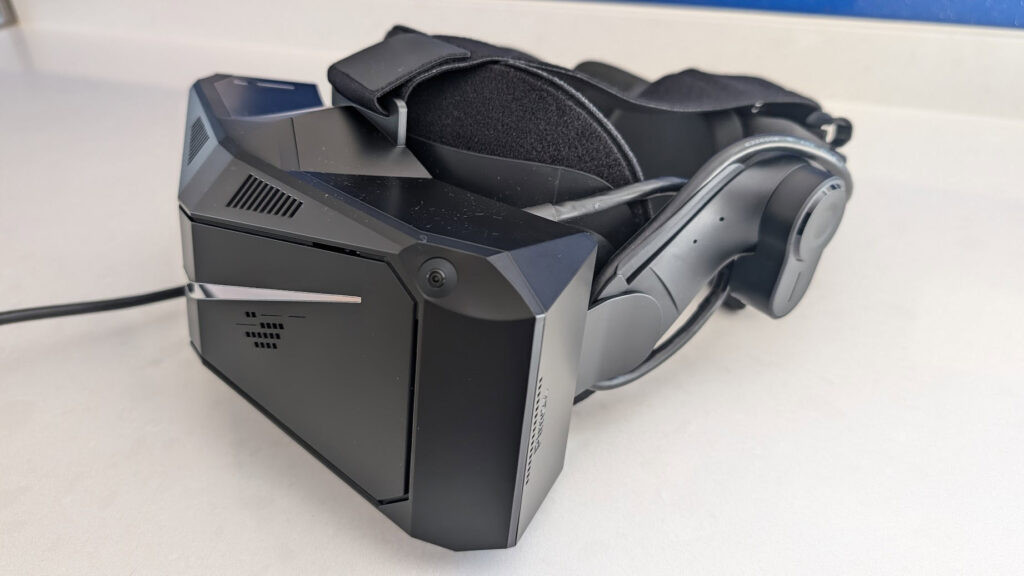

Standalone storage and foveated rendering are now fixed, instead of dynamic. All of this contributes to a weight saving of 317g (down from 1268g), which is approximately a 25% decrease in weight from the original Crystal to the Crystal Light.
I’ll update this page with the test results, however I am pleased with the outcome. Cable bulk and weight are reduced which makes it easier to work with. The clarity and overall definition is unchanged from its more expensive counterpart. Here are my initial impressions of the Pimax Crystal Light including a guide to unboxing, installation and some early settings for better visual performance.
The spiritual successor to the Quest 2, the Meta Quest 3 is a versatile virtual reality headset that’s gained a lot of attention in the sim racing and modding community. Released in late 2023, it offers several improvements over its predecessor, the Quest 2, but really, it’s the price that keeps my attention: $649 for the 512mb version. That’s less than half of the price of some of the “higher-end” VR headsets on this page, which makes VR far more accessible for sim racers.


The Quest 3 features pancake lenses and a higher resolution display over the Quest 2, providing clearer visuals and a wider field of view (FOV). With a resolution of 2064×2208 per eye, the increased pixel density helps reduce the ‘screen door effect’ that was more noticeable in previous generations. The headset’s mixed reality capabilities, while not directly applicable to sim racing, are a nice party piece too; you know – for when you need a break from hard racing.
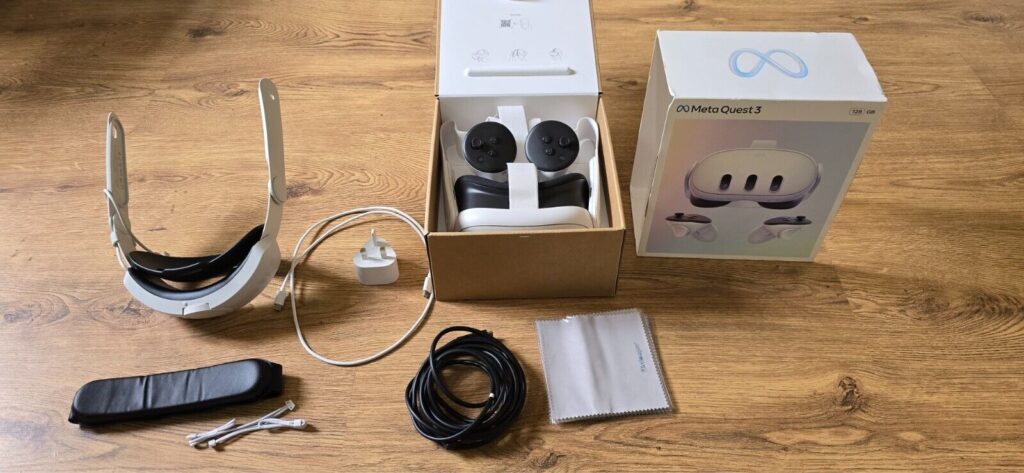

For sim racers, the Quest 3’s improved performance when connected to a PC via Oculus Link is a good thing to be aware of. The 3 supports a refresh rate of up to 120Hz. The headset is light too, weighing around 515 grams.
However, a small downside is battery life. If you use wireless connectivity, the Quest 3’s battery typically is good for 2-3 hours. Obviously, this is a non-issue with the link cable, and in any case, the performance is generally superior with a direct cable connection.
In terms of compatibility, the Quest 3 works well with popular racing titles like iRacing, Assetto Corsa Competizione, and rFactor 2. Ross recently wrote about the best VR sim racing games (and, he happens to run a Quest 2 so he knows what he’s talking about!). With any VR setup, optimisation is key – luckily we’ve looked at setting up the Quest 2, the principles for which apply to the Quest 3, too. A moderately powerful gaming PC is always recommended to take full advantage of the headset’s capabilities in demanding sims.


While opinions vary, many sim racers find the Quest 3 to be a solid choice for VR racing. I’ve found the improved clarity and wider field of view work really well.
If you’re not keen to invest upwards of $1500 for the next technological step up, the Quest 3 ticks all the boxes. It’s not as cooling as the Varjo Aero below (to be fair the Aero has fans built in!) but for comfort and lightness, it beats most of the other headsets hands down. This is a great choice for VR sim racing – especially priced at $640/£615.
Varjo Aero
- Compatibility: Windows 10 / 11 and Steam VR
- Display: 2 x 3.5″ diagonal
- Resolution Per Eye: 2880 x 2720 px
- Refresh Rate: 90 Hz
- FOV: 115° (134° at 12 mm eye relief)
The Varjo Aero is what I refer to as “Gen 3” VR. It’s a leap forward in every single way in comparison to the other headsets on this list. The only reason that might put most people off is the price. It’s expensive!


Aside from the seriously good optics which happen to be very high-spec (Dual Mini LED LCD; 2880 x 2720 px per eye), The Varjo has a 200hz eye tracking system, built-in fans to keep your face cool (active cooling) and, built-in audio. The display offers “no reflections with no ghost rays”.
It comes supplied with a 5m cable and weighs just 487g plus the headband at 230g. It feels lightweight and offers very high detail indeed. It runs on SteamVR (my preferred choice).
It’s priced at €1,990.00 / $1,990.00 – I recommend you upgrade your PC to get the most out of it, but apart from this, the Varjo is my current favourite, thanks to the ventilation! Wearing a VR headset can be uncomfortable in hot weather – the Aero tackles that problem by keeping you cool as you drive.
Pimax Crystal
Technical Specifications:
- Compatibility: Windows 10/11 with Steam VR / WMR compatibility
- Display: QLED+MINI LED panel combination
- Resolution Per Eye: 2880 x 2880
- Refresh Rate: 120 HZ (even at native resolution)
- Visit Pimax.com
- Read my In-Depth Review
The Pimax Crystal VR Headset sits firmly in the high-end performance / power-hungry space.
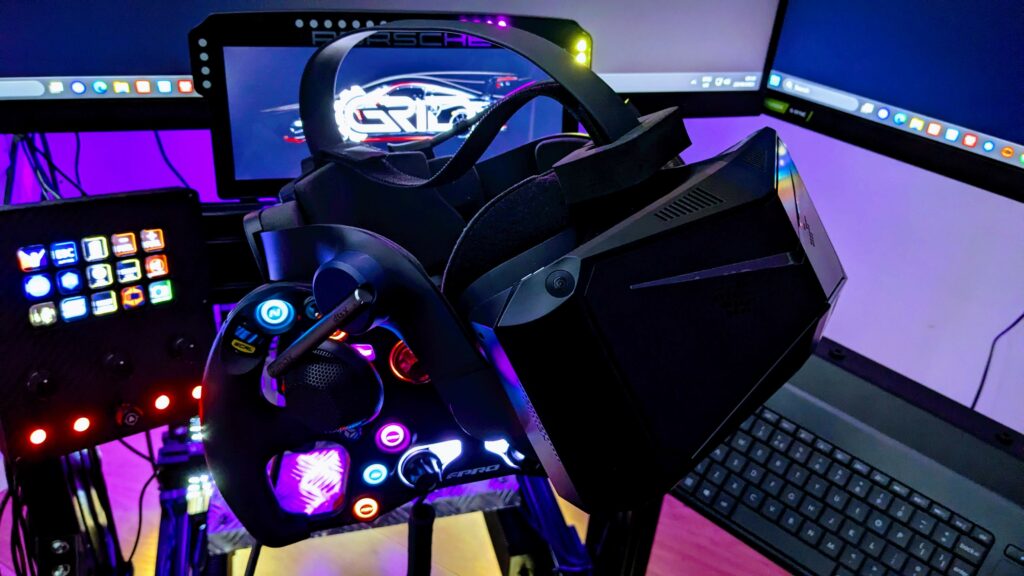

Upon unboxing, the Pimax Crystal features that all too familiar Pimax minimalist aesthetic, with its packaging devoid of excessive labelling, simply adorned with the “Pimax” logo. The headset showcases a signature angular design, which serves more than just aesthetic purposes: it distributes weight evenly, enhancing user comfort. The design aims to offer an ergonomic, comfortable wearing experience. The weight distribution is well balanced, so (I found) wearing it for long periods of time was not a problem.
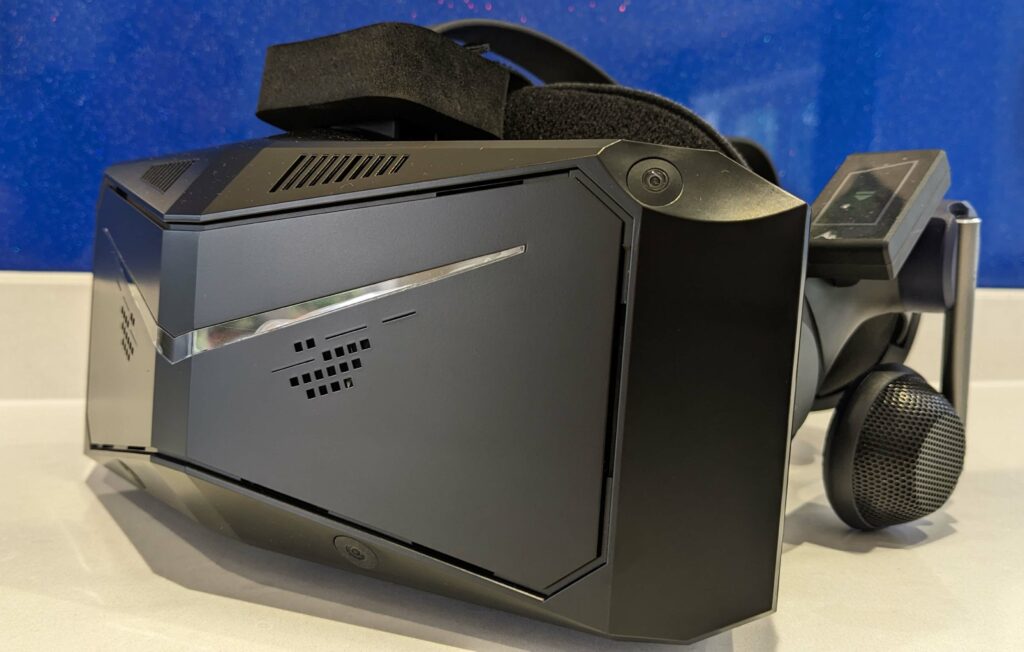

The setup process for the Pimax Crystal is user-friendly, with the Pimax Play software guiding users step by step. From charging the controllers to connecting the headset and initiating Steam VR, the entire process is intuitive and hassle-free, taking mere minutes.1
The Pimax Crystal boasts an impressive 2880 x 2880 resolution per eye, ensuring crisp and highly realistic visuals. Combined with the advanced QLED+MINI LED panel, this headset delivers impressive clarity, with the graphics displaying detailed output. It’s this type of advantage that should appeal to sim racers as driving is fundamentally using your eyes to set brake points (amongst other things). The Crystal operates with a very wide field of view and overall, this has been a favourite of mine since the long-gone days of owning a Valve Index.
The Pimax Crystal further enhances the user experience with features like eye-tracking, auto IPD adjustment, and a choice between two lens options, offering varying degrees of FOV (the lens supplied with the Pimax offers 115° of FOV.
Technical Specifications:
- Compatibility: Windows 10 / 11 / Steam VR
- Display: 1 x 5.46” diagonal
- Resolution Per Eye: 1832×1920
- Refresh Rate: 90 Hz
- FOV: 115°
The first thing that people fuss about with the Oculus (Meta) headsets is knowing whether you need a Facebook account to run one. You don’t need a Facebook account, after the V28 update. However, you do need to sign up for a Meta account, which is free of any social media tethers.
Oculus Quest and Oculus Quest 2 users can no longer use a Facebook account to log into their VR headsets. Instead, users will need to make a new Meta account that is separate from any social media presence. Thanks, Android Central!
Ross recently wrote a setup guide for Meta Quest 2 owners wanting to get the most out of their headset; so, take a look at that article if you’re considering picking up a classic Quest 2.
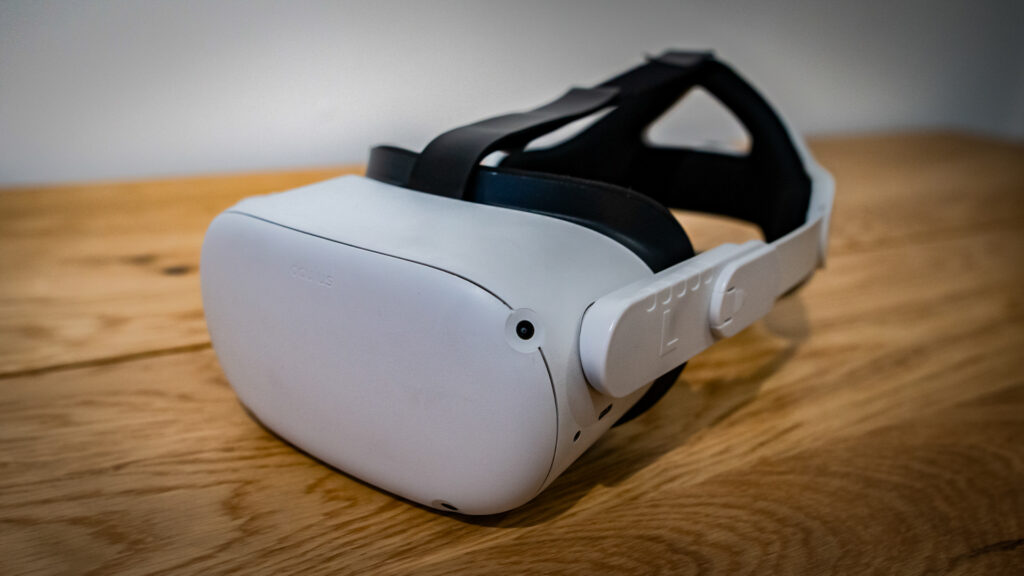

The V29 update brought updates to all sorts of areas but critically, stability improvements to Air Link and also gives us 120 hz refresh rate support for Air Link.
Check you’re running V29 by heading to the settings > about tab and make sure you’re running the latest version. 120hz refresh is available in “experimental features”
The Oculus Quest 2 is very easy to set up and get racing. I found that it feels light while wearing and it renders frames smoothly during use on my PC. It also suits gaming PCs that might be considered a little underpowered by modern standards, as it runs perfectly well on older NVIDIA 20 series cards.
Samsung HMD Odyssey+
Technical Specifications:
- Compatibility: Windows 10 / 11
- Display: Dual 3.5″ AMOLED Displays
- Resolution Per Eye: 1440×1600
- Refresh Rate: 90 Hz
- FOV: 110°
The Samsung Odyssey+, while now discontinued, offers a 90hz refresh rate in comparison to its predecessor, the Quest, at 72hz. You can pick good condition used examples of the Odyssey+ on eBay very cheaply.


Despite its age and the fact it is no longer available, there are always opportunities to pick up a bargain on eBay, usually for around $200.
The Odyssey+, according to these Redditors, “is the best OLED HMD on the market, period.” So, if you’re tight on budget and you can find a good one of these on the second-hand market, grab yourself a bargain (just make sure it comes in good condition, boxed with controllers and working!).
HTC Vive Pro 2
Technical Specifications:
- Compatibility: Windows 10/11 – Steam VR
- Display: 2 x 3.5” diagonal
- Resolution Per Eye: 2448 × 2448
- Refresh Rate: 90 – 120 Hz
- FOV: 120°
VIVE Pro 2 from HTC is the successor to the hugely popular HTC VIVE Pro, also an excellent VR headset. It’s a powerful, immersive headset with access to SteamVR base stations for content, and a high-end pair of AMOLED screens running at a combined 4896 x 2448px resolution..


The Pro 2 also comes with spatial audio and a comfortable ergonomic design to make sure you won’t start feeling it during an endurance race.
Some of the VIVE Pro 2 from HTC features include an ergonomic design with IPD adjustment and an optimised centre of gravity for headset weight management.
It features high-resolution spatial audio and a pair of high-per-eye resolution AMOLED screens running at a 120 Hz refresh rate. Like the Meta Quest 2, it’s a wireless design, although it runs at a slightly lower resolution and refresh rate in wireless mode.
A standout feature is the 120-degree FOV. There’s no need for cables (provided the battery is charged it’ll run for around 4 hours), though you will need the SteamVR 2.0 base stations to access Steam and SteamVR content through VIVE. To access the full potential of this headset, however, you will need to use the supplied cable. While this unit is several years old (a “gen 2” VR headset in my opinion), I thought it was a better headset than the Valve Index.
Oculus Rift S
Technical Specifications:
- Compatibility: Windows 10 and 11
- Display: Fast-switch LCD
- Resolution Per Eye: 1280×1440
- Refresh Rate: 80 Hz
- FOV: 115°
The Oculus Rift S is a great budget VR headset for sim racers, priced at $300.
The Rift S is Oculus’s second iteration in the Rift Series with the Rift S taking the place of the original Rift the Rift S has an advantage over other VR headsets in that it doesn’t require any separate sensors. So, the only sensors you’ll use are the ones that are already located on the headset, no extra cables or power supplied!


There’s an array of five cameras on the headset: two on the front, one on either side and one on the top. These five cameras do an amazing job at tracking where you are in the room and where the controllers are which use a separate infrared array to keep their position up to date. Not that I use controllers for sim racing, but for gaming generally that’s a useful thing to know.
The Rift S has only one cable running from the headset to your PC which connects via DisplayPort and USB3. This cable can be detached and replaced if needed.
The Rift S doesn’t have any headphones and instead uses a small speaker located on the head strap. They still sound pretty well and might.
In terms of comfort, the Oculus has a crown head strap which can be tightened and loosened at the back with a rotary adjuster.
VR Headsets: Price and Feature Comparision
| Product Name | Resolution Per Eye | Refresh Rate | FOV | Useful Details for Buyers | Price (USD) | Price (EUR) |
|---|---|---|---|---|---|---|
| Pimax Crystal Light | 2880 x 2880 | 60, 72, 90, 120 Hz | 103° | Lightweight version of Crystal, manual IPD adjustment, QLED display | $899 | €849 |
| Meta Quest 3 | 2064 x 2208 | Up to 120 Hz | – | Improved clarity, wider FOV, mixed reality capabilities | $499 (128GB), $649 (512GB) | €549 (128GB), €699 (512GB) |
| Varjo Aero | 2880 x 2720 | 90 Hz | 115° (134° at 12 mm eye relief) | High-spec optics, eye tracking, built-in fans, active cooling | $990 | €990 |
| Pimax Crystal | 2880 x 2880 | 120 Hz | – | QLED+MINI LED display, eye-tracking, auto IPD adjustment | $1,599 | €1,499 |
| Meta Quest 2 | 1832 x 1920 | 90 Hz | 115° | Wireless capability, no Facebook account required | $299 (128GB), $399 (256GB) | €349 (128GB), €449 (256GB) |
| Samsung HMD Odyssey+ | 1440 x 1600 | 90 Hz | 110° | AMOLED displays, discontinued but available second-hand | $499 | €469 |
| HTC Vive Pro 2 | 2448 x 2448 | 90 – 120 Hz | 120° | High resolution, wireless capability, requires base stations | $699 (headset only), $1,199 (full kit) | €739 (headset only), €1,399 (full kit) |
| Oculus Rift S | 1280 x 1440 | 80 Hz | 115° | No separate sensors required, budget-friendly option | $399 | €449 |
